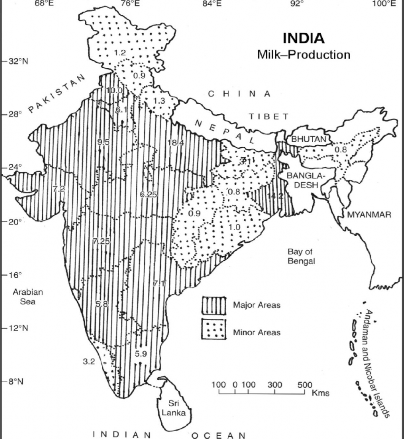Achievements
White Revolution is as important to dairy development as Green Revolution has been to grain production. Its outcome is based on the improvement in cattle breeding and adoption of new technology.
Today, India has earned the first position in milk production in the world. In 2009-10, livestock sector produced 112.54 million tonnes of milk as compared to 54 million tonnes in 1990-91. (Table 9.15). Dairying has become an important role in providing employment and income generating opportunities. The contribution of milk alone in 2005-06 was over 1.25 trillion, which is much higher than that of paddy (0.75 trillion). The statewise distribution of milk production has been shown in Fig. 9.20. It may be observed from this figures that Gujarat, Maharashtra, U.P., Punjab, Haryana, Madhya Pradesh, Rajasthan, West Bengal, Andhra Pradesh, Karnataka, and Tamil Nadu are the main milk-producing states of the country.
Some of the important achievements of the White Revolution are as under:
1. The White Revolution made a sound impact on rural masses and encouraged them to take up dairying as a subsidiary occupation.
2. India has become the leading producer of milk in the world. The milk production that was about 17 million tonnes in 1950-51 rose to over 112 million tonnes in 2009-10. The production of milk has gone up by more than six times when compared with that of the Pre-Independence situation.
3. The per capita availability of milk per day at present is about 263 gm as against 125 grams before the White Revolution.
4. The import of milk and milk production has been reduced substantially.
5. The small and marginal farmers and the landless labourers have been especially benefitted from the White Revolution. About 14 million farmers have been brought under ambit of 1,35,439 village level dairy co-operative societies. At present (2012), there are 200 million litres across India producing 20 million litres of milk every day.
6. To ensure the success of Operation Flood Programme, research centres have been set up at Anand, Mehsana, and Palanpur (Banaskantha). Moreover, three regional centres are functioning at Siliguri, Jalandhar, and Erode. Presently, there are metro dairies in 10 metropolitan cities of the country, beside 40 plants with capacity to handle more than one lakh litres of milk.
7. Livestock Insurance Scheme was approved in February 2006 and in 2006-07 on a pilot basis in 100 selected districts across the country. The scheme aims at protecting the farmers against losses due to untimely death of animals.
8. To improve the quality of livestock, extensive cross breeding has been launched.
9. For ensuring the maintenance of disease-free status, major health schemes have been initiated. 10. The government implemented livestock insurance on pilot basis in 2005-06.

Fig. 9.20 Milk Production Percentage (2007-08)
The All India Summary Reports of the 17th Livestock Census released in July 2006 points out that India possesses the largest livestock population in the world after Brazil. It accounts for about 56 per cent of the cattle population of the world’s buffalo population and 14 per cent of the cattle population. It ranks first in respect of buffalo and second in respect of cattle population, second in goat population and third in respect of sheep in the world.
